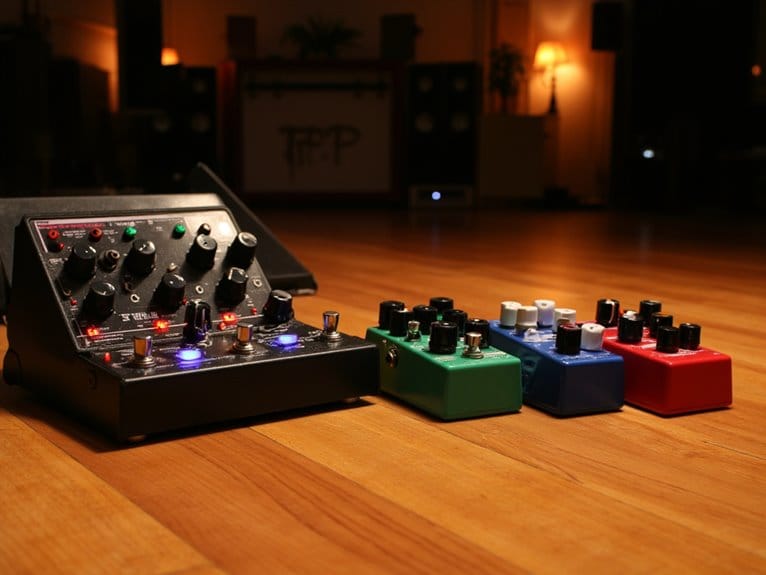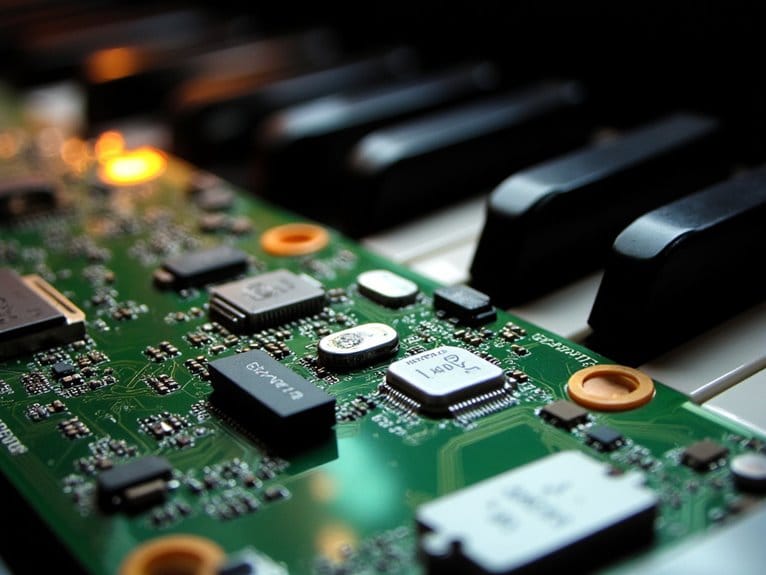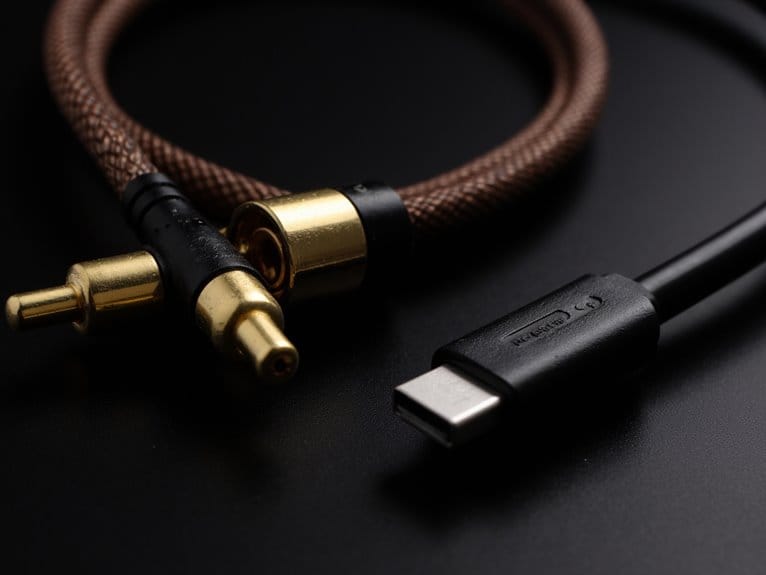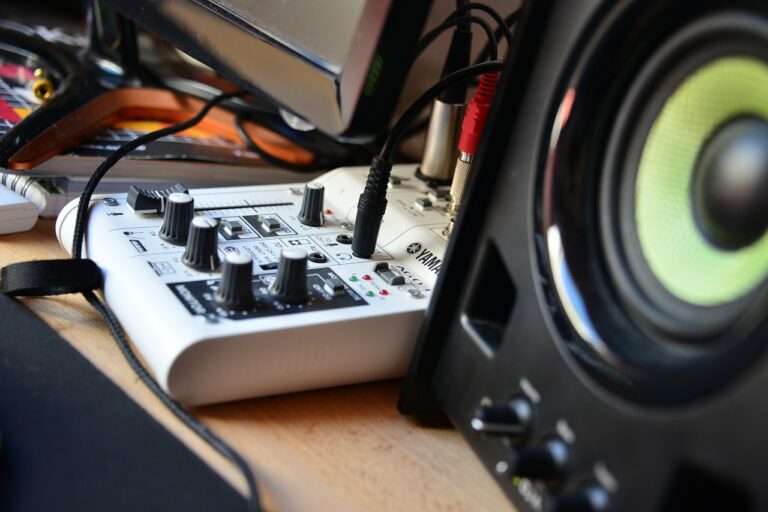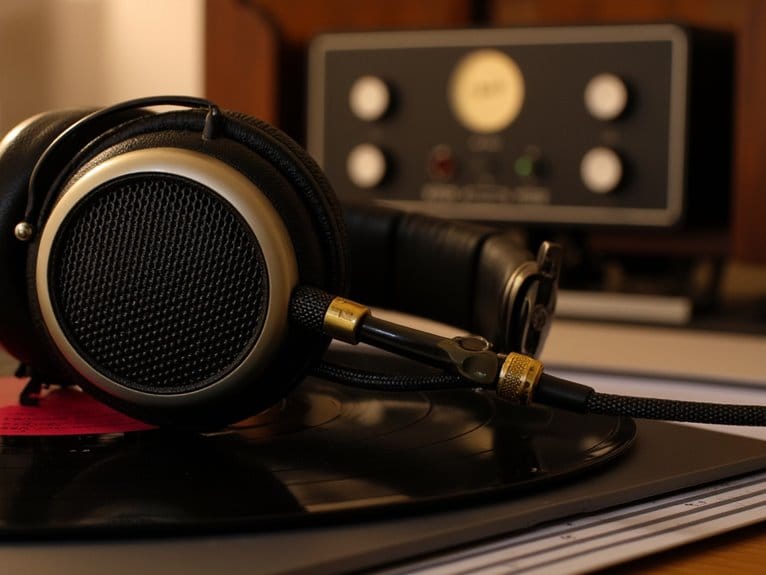Multi-Effects vs. Individual Pedals: Pros and Cons
Multi-effects units offer exceptional value at $649-$999, delivering consolidated effects, amp modeling, and audio interface capabilities in one portable package, while individual pedals cost $1,000-$4,000 but provide superior analog warmth and intuitive tactile control. You’ll appreciate multi-effects for quick preset switching and simplified setup, though they require programming knowledge and digital navigation. Individual pedals excel in live tweaking scenarios but demand extensive cable management and risk noise accumulation without proper buffering-considerations that become clearer when examining specific performance contexts.
We are supported by our audience. When you purchase through links on our site, we may earn an affiliate commission, at no extra cost for you. Learn more.
Notable Insights
- Multi-effects units cost $649-$999 while quality pedalboards exceed $1,000, with boutique options reaching $3,000-$4,000.
- Individual pedals offer superior tactile control with dedicated knobs, while multi-effects require digital navigation with steeper learning curves.
- Multi-effects provide instant preset switching ideal for live performances, eliminating “tap dance” between multiple pedal switches.
- Analog pedals deliver warmer sound with zero processing latency, though modern digital algorithms closely match analog quality.
- Multi-effects offer better portability and simplified setup, while individual pedals require extensive cable management and longer setup times.
Cost and Value Comparison
When I first started exploring guitar effects, the sticker shock of building a thorough pedalboard versus buying a single multi-effects unit caught me off guard, and honestly, the math gets pretty interesting when you dig into the real costs.
Your initial investment for a quality multi-effects pedal ranges from $649 to $999, while assembling an equivalent pedalboard easily surpasses $1,000 with mid-range pedals, potentially reaching $3,000-$4,000 with boutique options.
However, multi-effects units deliver exceptional value by consolidating numerous effects, amp modeling, loopers, and audio interface capabilities into one device. Many modern multi-effects processors include 24-bit/192 kHz recording capabilities that eliminate the need for separate audio interfaces. The long term savings become apparent when you consider reduced failure points, fewer accessories needed, and firmware updates that expand functionality without additional hardware purchases, making multi-effects particularly attractive for extensive sound exploration.
Budget-conscious beginners can find multi-effects units with 36-80 presets that allow comprehensive sound exploration at a fraction of the cost of building an equivalent individual pedal collection.
Performance and Practicality
Beyond the financial considerations, the real-world performance differences between multi-effects units and individual pedals become evident the moment you step on stage or into a recording session. Multi-effects units excel in live settings through their consolidated control systems, allowing you to switch between complex presets instantly without the dreaded “tap dance” across multiple switches. However, individual pedals offer immediate tactile feedback that’s invaluable when you need quick adjustments mid-song.
| Aspect | Multi-Effects | Individual Pedals |
|---|---|---|
| Setup Time | Quick, single unit | Extended pedalboard setup |
| Live Control | Menu navigation required | Direct knob access |
| Portability | Compact, fewer cables | Bulky, multiple connections |
| Reliability | Single point of failure | Distributed risk |
Your pedalboard setup choice ultimately depends on whether you prioritize convenience or hands-on control during performances. If you value ease of use and quick adjustments, you might lean towards integrated multi-effects units. However, if you prefer a more tactile experience and the unique character of individual effects, building a custom pedalboard could be the way to go. Additionally, consider the true bypass pedal advantages, as they can significantly enhance your tone by preserving the quality of your signal chain.
Sound Quality and Tonal Characteristics
While specs and features matter on paper, I’ve found that the most heated debates among guitarists center on one fundamental question: does your gear actually sound good?
Individual analog pedals typically deliver superior sound warmth through minimal processing latency, preserving natural harmonics that create an organic, “alive” tone. Digital multi-effects have dramatically improved, with high-resolution algorithms nearly matching analog quality, though some purists detect subtle artifacts.
Analog pedals preserve natural harmonics for organic tone, while modern digital algorithms nearly match that warmth despite purist concerns.
You’ll get immediate, tactile control with individual pedals, enabling intuitive tonal dynamics adjustments during performance. Multi-effects excel at preset management and complex layering capabilities unavailable with separate units.
However, analog pedal chains can accumulate noise without proper buffering, while quality multi-effects maintain consistent signal fidelity internally, simplifying noise management across your entire signal path.
User Experience and Technical Requirements
Having spent countless hours wrestling with both complex multi-effects menus and sprawling pedalboards, I can tell you that your choice between these approaches will fundamentally shape how you interact with your gear during practice, recording, and live performance.
Individual pedals offer an intuitive user interface with dedicated knobs providing immediate parameter access, while multi-effects units present a steeper learning curve due to digital navigation and menu systems. You’ll find that stompboxes deliver superior tactile feedback for live tweaking, though they demand more setup time and cable management.
Multi-effects excel at preset switching for complex arrangements but can intimidate beginners with their programming depth. Modern digital units minimize latency to imperceptible levels, though analog pedals maintain zero processing delay advantages.
On a final note
You’ll find both multi-effects units and individual pedals offer distinct advantages depending on your specific needs, budget constraints, and performance requirements. While multi-effects provide exceptional value, convenience, and versatility for beginners or touring musicians, individual pedals deliver superior sound quality, customization options, and long-term investment potential. I’ve learned that your choice ultimately depends on whether you prioritize practicality and cost-effectiveness or tonal precision and creative flexibility in your setup.

